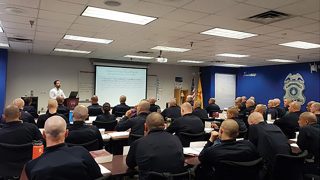
Picture this: being found guilty of a serious crime you didn’t commit. This is the harsh reality for some people who are regrettably misidentified by an eyewitness. Shockingly, the Innocence Project has revealed that over 60% of the wrongful convictions they have overturned were due to eyewitness misidentification. Let’s examine the factors contributing to these errors and the measures law enforcement can take to reduce them.
Research has indicated that following four simple rules can lower the criminal justice system’s contribution to mistaken eyewitness identification.
Innocent until proven guilty
It is a grave injustice whenever an innocent person is punished for a crime they did not commit. Voltaire, William Blackstone and Ben Franklin all agreed it is better to have many guilty people go free rather than one innocent person being convicted. This idea of protecting the innocent is foundational to our criminal justice system, and for good reason. The devastation to family, relationships, and mental and physical health is unfathomable when an innocent person is convicted of a crime. Lost time is something those who have been wrongfully convicted can never reclaim.
Steven Avery case
Numerous cases of wrongful convictions exist, but Steven Avery’s situation is particularly notable. Penny Beerntsen was assaulted and raped by a stranger while running near her home in Wisconsin. After she identified her attacker from a police lineup, he was convicted and given a 32-year prison sentence. For 18 years, Beerntsen was convinced that her rapist was guilty and incarcerated. However, in 2003, DNA evidence exonerated Avery, the man she had identified, revealing that he was not the attacker. Beerntsen expressed profound regret: “My testimony sent an innocent person to prison… I absolutely wanted the earth to swallow me.” Interestingly, Avery was later convicted of a murder and was sent to prison in 2005.
Ronald Cotton case
The Ronald Cotton case is one of the most influential cases that brought attention to the problem of eyewitness misidentification. Jennifer Thompson was raped in her Burlington, North Carolina, apartment. With some difficulty, from a lineup containing six photos, she chose two pictures, one of them Ronald Cotton’s. “I think this is the guy,” she said, pointing to Cotton. The lead detective asked, “You’re sure?” She answered, “Positive.”
When Thompson then asked, “Did I do OK?” the detectives replied, “You did great.” She has later described how those encouraging remarks helped her become more confident in her identification and a subsequent live lineup. As a result, Thompson was completely confident that Cotton was the rapist. The case went to trial, and Cotton was convicted of rape. The issue, however, was that Cotton was innocent, a fact that DNA testing proved after he had spent almost 11 years in prison.
Embracing change
The detective in the Cotton case was Mike Gauldin, who later became the chief. Admirably, in response to this mistake, Gauldin pioneered new cutting-edge practices, including double-blind lineup procedures. Remarkably, Cotton and Thompson also co-authored a book called Picking Cotton, detailing their case and bringing attention to the problem of eyewitness misidentification. The book also highlights Cotton’s incredible forgiveness toward Thompson.
Best practices
In recent years, state legislative branches and police policies and procedures have made big strides in implementing best practices to help reduce eyewitness misidentifications. Research has indicated that following four simple rules can lower the criminal justice system’s contribution to mistaken eyewitness identification. These rules are:
- Who conducts the lineup: The person who conducts the lineup or photo lineups should not be aware of whom the suspect is. (Obviously, in rural areas, this is more difficult.)
- Instructions on viewing: Eyewitnesses should be told explicitly that the person in question might not be in the lineup or photo lineups, and therefore they should not feel that they must make an identification. They should also be told that the person administering the lineup does not know which person is the suspect in the case.
- 3Structure of lineup or photo lineups: The suspect should not stand out in the lineup or photo lineups as being different from the distractors based on the eyewitness’s previous description of the culprit or based on other factors that would draw extra attention to the suspect.
- Obtaining confidence statements: A clear statement should be taken from the eyewitness at the time of the identification, and prior to any feedback, as to their confidence that the identified person is the actual culprit.
Notably, policies and procedures often fall within the control of the police departments. Therefore, departments should ensure that their policies are deliberately aligned with best practices and officers are being trained on them. Furthermore, the pursuit of continuous improvement remains important as we deepen our understanding of the various causes of eyewitness misidentification through research.
Research insights: What factors contribute to eyewitness misidentification?
- Strangers: The research indicates eyewitness misidentification is most likely to occur when a stranger commits a crime toward a victim. In addition, two common types of serious crimes committed by strangers are robbery and rape.
- Stressful situations: The research indicates many people believe a witness because they are highly focused and alert during a crime. Nevertheless, studies indicate that the stress experienced in such scenarios impairs, not enhances, the creation of precise memories.
- Weapon focus: The research indicates that when a suspect brandishes a weapon, victims and witnesses often become fixated on the weapon itself, leading to inaccuracies in their recollection of other details, such as the suspect’s appearance. This phenomenon is known as “weapon focus.”
- Cross-racial identifications and age: The research indicates that cross-racial identifications are significantly less accurate compared to same-race identifications. Moreover, children demonstrate a lower reliability rate in identifying suspects than adults.
- Duration of the witness’s observation: The research indicates that longer observation times lead to more accurate suspect identifications compared to shorter durations.
- Distance of the witness’s observation: The research indicates that the farther away the suspect was from the witness, the less likely the witness was able to identify the suspect.
- Time between seeing something and trying to recall it: The research indicates that even if someone remembers a lot of details on the day of the crime, they are no better than chance at identifying the suspect from a photo lineup after 11 months. Time really affects how reliable eyewitnesses are. Also, memory fades fast, even within hours, not just days or weeks like many believe.
- Memory contamination: The research indicates that when eyewitnesses see a picture of someone on the news presented as the person arrested for the crime, they are more likely to recall that face as the suspect, even if it’s not the same face they saw during the crime. In his book Blind Injustice, Mark Godsey gives the example that the police may ask a witness a question suggesting whether the perpetrator’s mustache was bushy or trimmed, and the witness suddenly unintentionally remembers a mustache on the clean-shaven suspect that he saw the week before. While not intentional, the witness’s memory is altered.
- Unwarranted confidence: The research indicates that when witnesses receive positive feedback about their identification, like in the Cotton case discussed prior, their confidence significantly increases. As a result, the witness will be more likely to testify in court, inaccurately. Even if a police officer’s body language suggests that the victim picked the correct suspect, it can also affect the confidence level of the witness. Importantly, the research suggests that the witness’s confidence level at the time of the initial identification is the most accurate indicator.
Conclusion
No one wants wrongful convictions to occur — not the police, not the victim and certainly not the wrongfully accused. Our justice system is built on the very principle that innocent individuals should not be punished. Yet, even with this foundational principle and good intentions, criminal justice professionals can still perpetuate eyewitness misidentifications. In sum, we can fall prey to our perceptions. As law enforcement, it is important to have a thorough understanding of all the factors contributing to eyewitness misidentifications, or they are bound to continue to occur. Having a strong understanding of eyewitness reliability variables can help ensure that fewer instances of eyewitness misidentifications happen under our watch.
As seen in the April 2024 issue of American Police Beat magazine.
Don’t miss out on another issue today! Click below:





